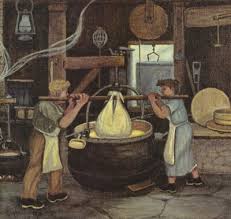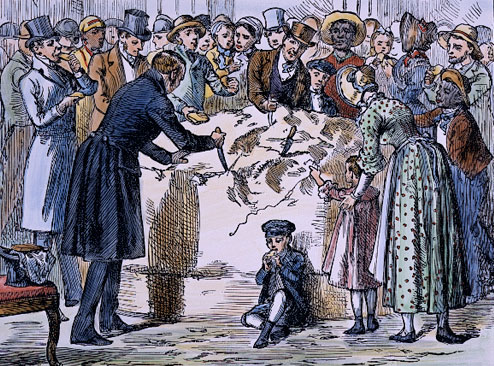Cheese
Practically all cultures include cheese (no pun intended). It basically an offshoot of milk, whether from a cow, a sheep or a goat, etc. to include the curd. As one would expect, the different animal milk produces different types of cheese. A cheese press covered with cheese cloth (no surprise regarding the name) is used to collect the milk and curd, and pressed to smooth all the lumps. After a certain amount of time for aging, etc., a round wheel of cheese is produced. Some are very small. Some are very large.
The Election of 1800
In a phrase, the presidential election of 1800 was indeed very cheesy (groan), with incumbent John Adams (MA), a Federalist, losing to an unexpected and convoluted tie between Thomas Jefferson (VA) and Aaron Burr (NY), both considered “Republicans” (a forerunner to the Democrats). Burr’s original intention was to become Vice Presidency, but his decision (because of the tie) was to challenge/opt for the Presidency. Thus the definitely cheesy part. The House of Representatives had to weigh in on that decision.
They selected TJ as President, and Aaron Burr as Vice President. (As an aside, the 12th Amendment was quickly proposed and ratified to ensure a separate ballot for POTUS and VP, so such a crisis would never occur again.)
The Massachusetts Baptists
Massachusetts was primarily an industrial and commercial state, with Puritan ethics of hard work and regular habits. By the the latter part of the 18th century, the Baptists had become a large offshoot of the Congregationalists, differentiating by minor changes in their liturgy. While most of industrial Massachusetts citizens were political Federalists in the manner of George Washington and John Adams, there was a growing number of “Republicans” – especially among the more agrarian Baptists in Cheshire, in the western part of the state, around the Berkshire Mountains.
One of their political leaders was John Leland, a preacher who was an ardent supporter of the separation of church and state. He had met Thomas Jefferson some time earlier, and respected him. They had become friends, and were particularly like minded on the church-state issue. Leland campaigned vigorously for TJ.
Let’s Send A Cheese!
There is something about cheese that lends itself to being a welcome gift. Cheese trays with fancy wedges wrapped in colored foil surrounded by other goodies abound – especially around holidays!
Once Jefferson was duly sworn in, John Leland organized his congregation to commemorate the occasion by sending the new President a gift. Since his town of Cheshire was primarily a dairy farming community, rather than collecting money per se, he urged every one who owned a cow to collect every quart of milk and curd from a single cow on a particular day. They were then instructed to bring it to a location where a large apple cider press had been commandeered for the cheese-making process.
The caveat: Only “Republican” farmers with “Republican” cows were invited to participate. Federal cows were not included. The milk from 900 cows was collected in the process and created a cheese that was 4’ across, 15” thick, and weighed more than a half ton! Alas, no tray, no fancy wedges and nobody knew about colored foil.
Pastor Leland insisted the cheese was made to show “profound respect” to the ratification of Jefferson’s election.
There was one more caveat: The farmers were all free-born. No slave labor was used to make the cheese.
When the cheese was ready to be shipped, the entire congregation gathered to sing hymns and say prayers over the massive cheese.
Shipping The Cheese
Nobody in Cheshire, or even in Berkshire County itself had a wagon large enough and strong enough to handle such a massive load. And the roads between western Massachusetts and Washington, a distance of nearly 500 miles, were primitive for the most part.
So a sleigh was hired to transport the cheese to a barge on the Hudson River, and float it down to New York City, where it was hefted aboard a sloop bound for Baltimore. Then it was hauled by a huge horse drawn wagon to Washington – and the President. The trip took three weeks. But that doesn’t really matter. Cheese is known to age very well.
When it was delivered on January 1, 1802, it came with a note, underscoring the fact that it was made from “Republican” milk, crafted voluntarily by the farming men, women and children of the town, and entirely done by free labor. Not a single slave assisted in its making.
President Jefferson praised it as proof of the domestic skills of the farmers of Berkshire County. He thanked them by cutting off a large chunk of the cheese to send back its “donors,” along with his personal check for $200 as a donation to their congregation. TJ was very particular about not accepting gifts. He likely thought it was cheesy.
It is said that chunks of the cheese were part of the White House July 4th celebrations.
Comparing Cheeses
Some thirty years later, President Andrew Jackson was also given a humongous cheese from his admirers. It sat aging in the lobby of the White House for nearly two years before AJ threw a huge party and invited everyone in town to come with their knives and napkins to partake.
It was also said to have left an odor that took months (maybe years) to dissolve, and even longer to clean out of the carpeting.
And don’t think they didn’t compare notes! Jefferson’s cheese was indeed larger, by as much as 200 pounds.
Sources:
John P. Kaminski, Thomas Jefferson: Philosopher and Politician. Parallel Press, 2005.
Moore, Virginia – The Madisons: A Biography – McGraw Hill – 1979
https://www.monticello.org/research-education/thomas-jefferson-encyclopedia/mammoth-cheese






